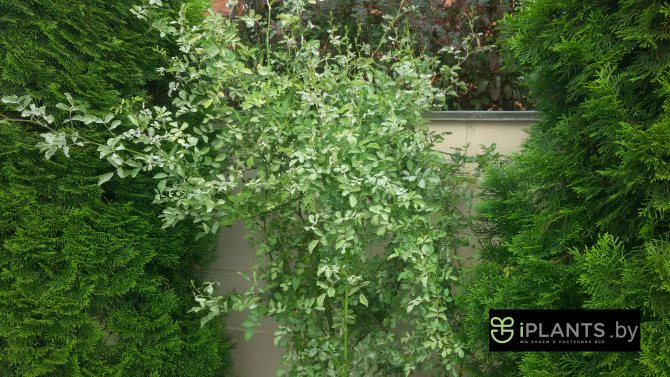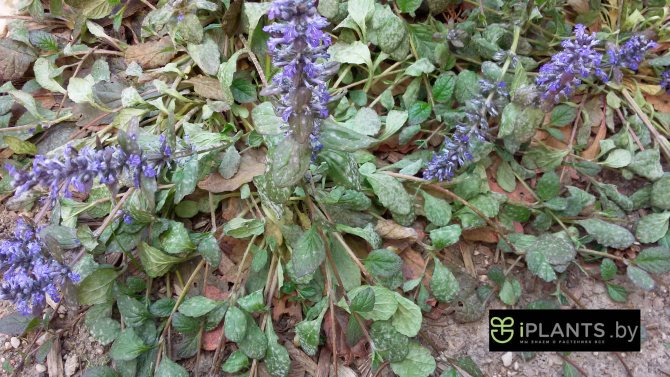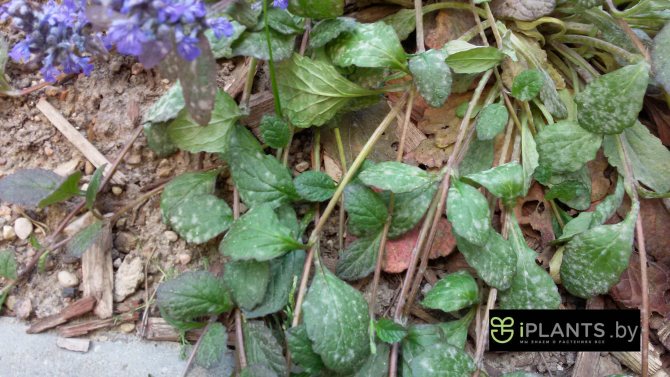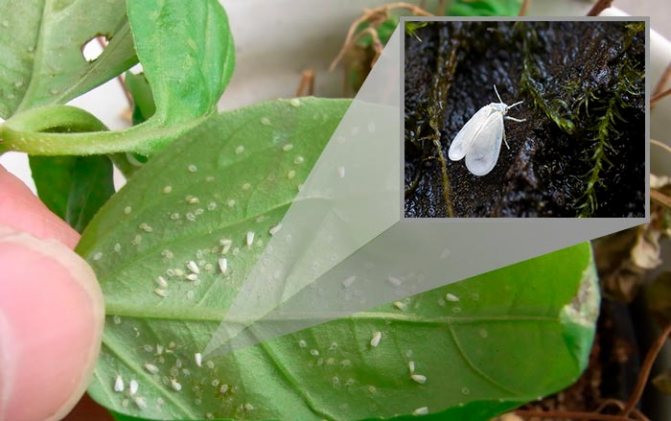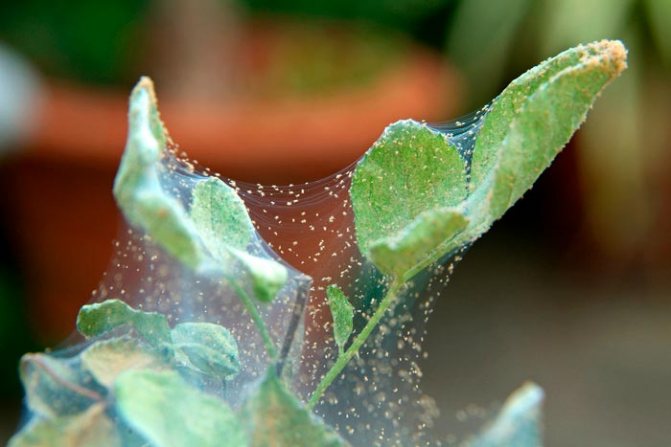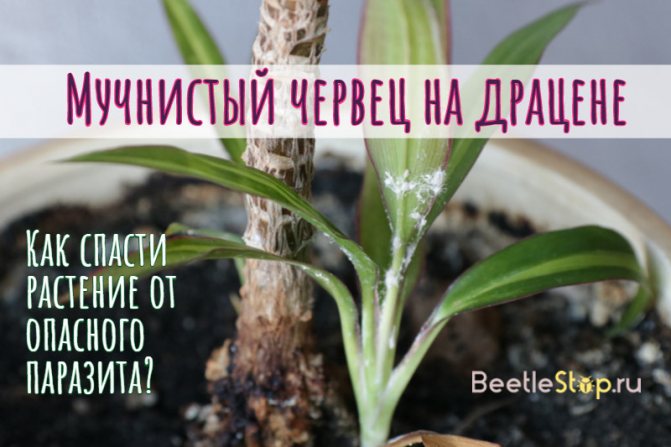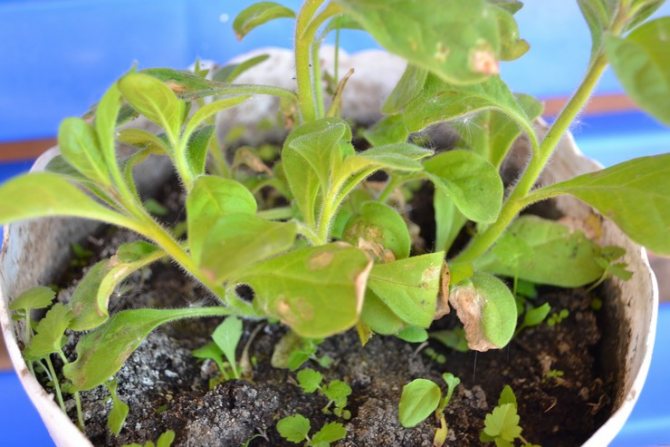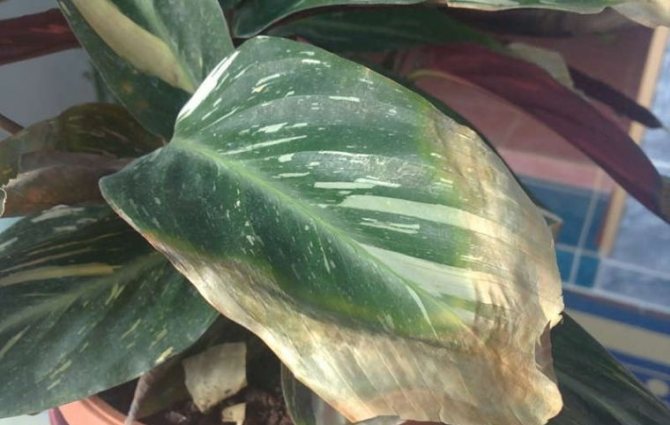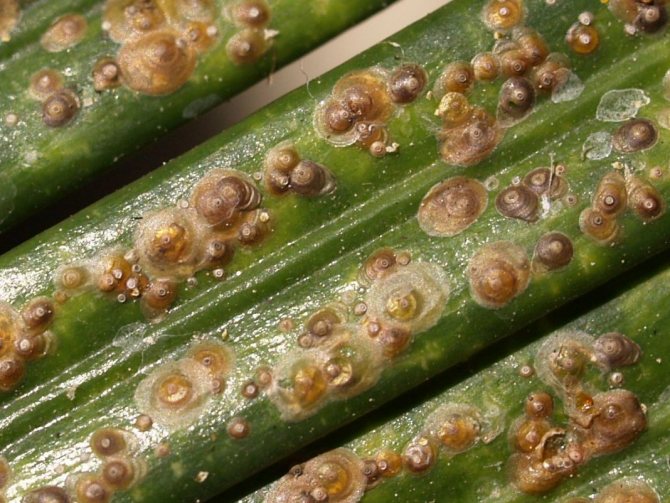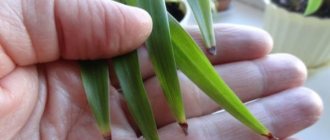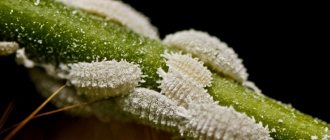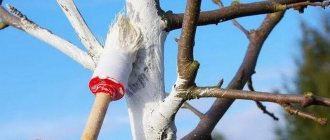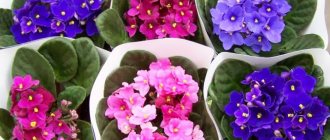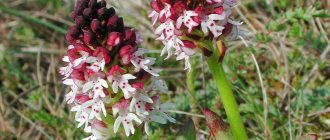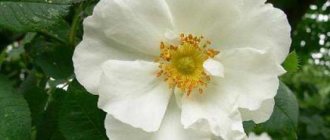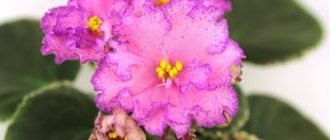Tags: plant treatment, outdoor plant treatment, powdery mildew
Unfortunately, many gardeners are well aware of this plant disease. It is found on garden trees and shrubs, on vegetables (cucumbers, squash, squash), as well as on many flowers. Let's try to find ways to fight.
Why does a sticky bloom appear on plants?
The first sign of serious problems is the untidy appearance of the flower - dust and small debris adhere to the leaves. The leaf plates of healthy houseplants are smooth or fluffy, but certainly not sticky. The appearance of any liquid on the tissues of the plant, except for the one that got in the process of watering, is an abnormal phenomenon that requires immediate intervention.
Sticky leaves in indoor plants, spots, drops or a layer of thick liquid on them are a signal that insect pests have appeared in the house. They feed on plant juices and secrete substances (waste products) that leave sticky spots on the leaves. Small pests bite through the leaves, juice is released from these holes.
Since insects drink juice that contains sugar, their natural secretions are thin and sticky. They mix with the sap of the plant, covering the leaf surface with a sticky liquid.
- deterioration in flower nutrition;
- the development of a fungal, bacterial or viral infection in places of damage to the leaf plate;
- difficulty breathing and evaporation of fluid;
- violation of the processes of photosynthesis;
- slowing down the movement of moisture and nutrients from the root system to other organs, a deficiency of minerals.
But not always the appearance of sticky spots is associated with pest damage. Under natural conditions, some plants secrete a sweet liquid to attract pollinating insects, mainly orchids.
Preventive measures
To significantly reduce the risk of damage to indoor violets from fungal diseases and pests is compliance with fairly simple rules of agricultural technology and the implementation of preventive measures.
According to experienced violet growers, the greatest danger is represented by violets (rosettes) purchased in street markets or from unscrupulous sellers. Without a month's quarantine, they should not be exhibited together with other house plants.
From the first day of purchase appropriate care and growing conditions should be established. Strictly follow the sequence of watering, timely and correctly apply fertilizers.
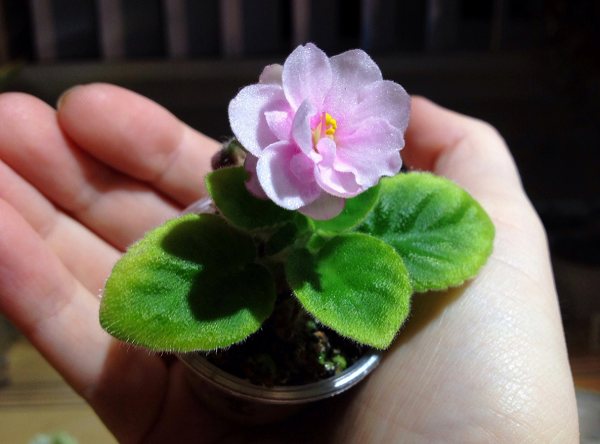
The best prevention of disease is proper care.
Prevention:
- quarantine;
- sterilization of containers and soil;
- the quality of the plant upon purchase;
- compliance with the rules of agricultural technology.
Important! A healthy, well-groomed plant is afraid of any diseases and pests.
How to identify a pest
A number of pests are known that leave a sticky layer on the leaf plates. Arachnid or hemiptera insects usually settle on indoor specimens. They are well adapted to indoor life, small in size, and cannot be seen without the use of a magnifying glass.
Pest penetration routes:
- With soil for replanting. Pre-disinfect the new soil or bake it in the oven to destroy eggs and larvae.
- With acquired plants. Beginners should be moved away from existing flowers.
- With air from the street during ventilation. To avoid this, install mosquito nets on the windows.
Whatever the reasons for the appearance, whoever is the culprit for the appearance of sticky leaves on indoor flowers, it is necessary to get rid of the disease immediately.
Aphids are small insects, body length is 2-3 mm. She is dyed white or greenish and prefers indoor flowers with delicate fabrics. Often, one of the first signs of infection is the appearance of syrup-like droplets of secretory fluid.
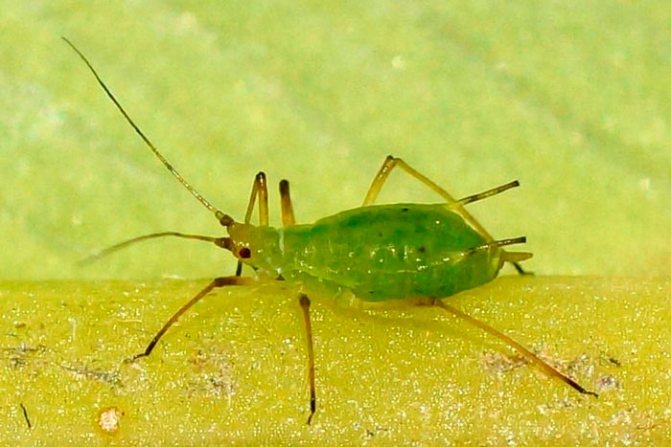

With a significant growth of the colony, the entire lower surface of the leaf plates is covered with parasites that destroy young shoots, do not allow the buds to open, and can introduce a fungus.


Shield
The family of hemiptera, to which the scale insect belongs, has more than 2600 species, most of which are dangerous pests that destroy garden and indoor plants. The scale is small; the length of the oval body is 2 mm. Having settled on an indoor plant, an insect in a short time can lead to its death. At the point of attachment, yellow spots appear, the leaves curl and fall off. The flower stops growing, dries up.
An important sign of the appearance of scale insects on indoor flowers is a sticky bloom. A viscous white liquid - pad, capable of completely covering the flower. The pad easily collects sooty fungus and dust.
The closest relative of this pest is a false shield, they belong to the same order, they lead the same parasitic lifestyle. The false shields are larger. It is not so easy to understand whether a shield or a false shield is in front of you. It seems that the false shield has a carapace on the back, but this is a layer of the skin that has died out after molting.
The main pest of indoor flowers is a soft false shield, it is capable of destroying any plant. The size of the insect is 3-4 mm, the oval body is brown in color. The insect leaves a sticky coating not only on the leaves, but also on the window panes, near which the pot is located.
Spider mite
This small pest from the class of arachnids is almost impossible to see with the naked eye, its size is 0.2-1 mm. They feed on the cell sap of plants, their salivary glands secrete special enzymes that destroy the chloroplasts of cells... Red spider mite is able to destroy any houseplant, it loves warmth, does not tolerate excess moisture... Shiny reddish eggs can be seen on leaves or cobwebs. After the allotted time, translucent larvae emerge from the eggs, which also feed on the juices of the flower.
Signs of disease in indoor plants affected by spider mites:
- sticky leaves;
- cobweb on the crown and stems;
- scratches, cracks on the back of the leaves;
- a decrease in the intensity of color due to a violation of the processes of photosynthesis;
- dying off of plant parts;
- impossibility of tying buds, falling of existing flowers.
We increase the livestock
The most difficult and troublesome way to reproduce calathea is growing from seeds. Even the best quality seed may not germinate.
Sowing of seeds is carried out in spring at a temperature of 20-22 ° C, using a soil consisting of 1 part of leafy soil and 0.5 part of sand. After the seeds germinate, the sprouts are planted in the soil of the same composition, and after a while, the grown and strengthened plants are planted in separate small pots.
When propagating, the plant propagation method is also used. To do this, the aboveground cutting must be carefully separated from the mother plant, planted in moist soil and covered with transparent material, film or a plastic bottle.
It is important not to remove the shelter before the baby is rooting.I would like to note that this is a rather complicated method, since not all growers manage to root calathea.


Reproduction of calathea by cuttings
The easiest and fastest way to propagate your pet is to split the bush. During transplantation, the main bush is carefully divided into several parts so that each one has several leaves and formed roots.
If a knife was used when dividing, then the sections must be sprinkled with crushed coal. The parts are seated in separate small pots in moist soil at a temperature of about 20-22 ° C.
At this time, additional care is needed, since the flower takes a very long time to take root.
First aid and methods of control
If you find harmful insects on the plant, do the following:
- Isolate the flower from other plants to prevent infestation.
- Prepare a soapy solution, remove insects and sticky deposits from leaves and stems with a soft cloth.
- Rinse the foliage under the shower, cover the soil in the pot with foil so that the washed-off pests do not get into it.
You can fight insects with the help of folk remedies intended for spraying:
- Pour 100 g of citrus peel with 1 liter of warm water, put in a dark place for 4 days.
- 1 head of minced garlic in 1 liter of water, leave for a week. Add 50 ml of infusion to 10 liters of water.
- 1 chopped onion per 100 ml of water, leave in a closed jar for 8 days. For 10 liters of water, 20 ml of infusion is enough.
- Pour 150 g of onion husks with 10 liters of boiling water, in a day the infusion is ready.
- Grate 100 g of laundry or green soap, dissolve in 5 liters of hot water.
- 50 g of tobacco dust, 5 liters of water and a little soapy water.
If folk remedies are ineffective, you need to use insecticides. You will notice the result immediately, you will need a minimum number of repeated treatments.
- "Aktara" - systemic insecticide, used to protect indoor plants from aphids, scale insects, worms, thrips. Affects whitefly and ticks worse.
- Fitoverm actellik Is one of the most powerful common drugs.
- "Arrivo" - insecticide of contact-intestinal action, has a high initial toxicity, has a long term of protective action (up to 2 weeks).
- "Spark" - several options made on the basis of different toxic substances. The most modern drug Iskra Bio (Akarin) is an environmentally friendly product that is harmless to humans and animals.
- "Inta-vir" effective means for the destruction of adults, but not capable of destroying larvae and eggs.
- Etisso Blattlaus-Sticks - sticks that are placed in the ground. After watering, the active substance is released and spreads through the root system to all plant tissues.
- "Commander" effective both when applied to the soil and when spraying.
When processing with chemicals, follow the instructions and safety rules:
- use protective devices - gloves, respirator;
- process outdoors, on a balcony, or in a well-ventilated area;
- keep chemicals out of reach of children and animals.
Read the instructions carefully, adhere to the recommended dosages and processing times.
To avoid the appearance of pests, inspect the plants, pay special attention to the back surface of the leaves, because this is a favorite place for insects. Observe the rules of care, do not violate the watering regime, feed indoor flowers in a timely manner. These simple measures will protect your plants from pest infestations.
Diseases of indoor plants with sticky leaves immediately reveal their cause and pathogen.
A sticky leaf in any plant means that organic secretions with a large amount of carbohydrates are deposited on its surface.


In a healthy plant, this is possible only if something that adheres to the outer covers of the leaf has fallen onto the leaf blade from the outside. This happens rarely. And if all the leaves of a plant suddenly become covered with something sticky, these are signs of a pathology that develops so quickly that soon not only a few leaves and the whole plant are covered with a sticky mass, but also the nearest space around. This indicates the presence of a constant process of violation of the integrity of the leaf blade.
This phenomenon has causes and consequences. The reasons are simple - microorganisms start on the plant that damage the leaves. As a result, juice flows from the wound of the leaf all the time.
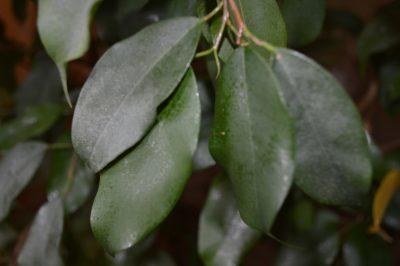

Reaching a certain number, the pest forms a sticky cover on the leaves. Because he drinks the juice, his secretions are not only runny but sticky. As a result, the leaf is covered with a continuous layer of a mixture of its own juice with the secretions of organisms that eat it.
This process can have the following consequences.
- 1. The plant loses water and nutrients.
- 2. Fungi, bacteria, viruses can settle on permanent damage, which can cause a new disease.
- 3. The sticky cover clogs the stomata, making it difficult for respiration and water evaporation.
- 4. Since the plant is not provided with sufficient oxygen and carbon dioxide, the formation of organic matter in the process of photosynthesis becomes unproductive. This leads to leaf loss and gradual wilting of the entire plant.
- 5. Closed with a sticky substance, the stomata cease to evaporate water. As a result, the movement of water from root hairs to leaves slows down. For this reason, the supply of minerals to the terrestrial organs of the plant also slows down. This is the reason for the deficiency of minerals. The intensity of bio and photosynthesis decreases. As a result, the plant ceases to bloom and bear fruit, gradually dying.
Folk remedies against powdery mildew
- 1st recipe: Dissolve 4 grams of soda ash in 1 liter of water, add 4 grams of soap. Stir thoroughly and spray the plants 2 times at weekly intervals.
- 2nd recipe: pour 0.5 cups of ash into 1 liter of boiling water, leave for 2 days, strain, add 4 grams of soap, previously diluted in water. Process twice with an interval of 7 days. With severe damage, there may be more treatments.
- 3rd recipe: Fresh mullein. To prepare the product, it is necessary to pour 1/3 of a bucket of fresh manure with cold water and leave for 3 days, stirring occasionally. Then filter through a thick cloth and dilute with water in a ratio of 1:10. Plants should be sprayed in the evening to avoid sunburn. A fresh infusion is prepared before each treatment.
- 4th recipe: Fermented water. To combat powdery mildew, you can use any garden weeds; with their help, the so-called fermented grass is prepared. To do this, pour 1/2 bucket of finely chopped weeds to the top with hot water, stir and leave for several days, then strain through cheesecloth. Spray in the evening.
- 5th recipe: Sour milk or kefir (yogurt). The preparation for spraying is prepared from the separated fermented milk whey, it is diluted in a ratio of 1:10 with cold water and stirred until a homogeneous solution is obtained. The prepared solution is poured into a sprayer and the plants are treated.
You can order Lechuza pots with automatic watering, plants or plant care services by calling: (vel) +375 (029) 171 94 42; (mts) +375 (029) 503 80 17, as well as provide the necessary advice. Contact!
Leave a request or
Sources of the problem
A healthy flower always looks natural and luxurious. Any deterioration in appearance should always be alarming. Why do indoor plants sometimes get sticky leaves? Why have our gentle beauties lost their attractiveness? Is this just an external flaw or is such a phenomenon really dangerous for our green friends? Unfortunately, this symptom suggests that our pets have become a refuge for small, sometimes invisible insects. Sticky plaque on the leaves of indoor plants is nothing more than an accumulation of waste products of pests. Who could have left him?
- Shields, or false shields - very small immobile insects from the Hemiptera family.They were named so because they are covered, like a shield, with a dense protective shell. To find them on the leaves, you need to take a good look at indoor flowers. The scale insects look like small slightly thickened brown-brown specks on the surface of the foliage. Sometimes the leaf near this tubercle becomes paler: parasites suck out its vital juices.
- Aphids - the second most popular pest that causes stickiness in house flowers. The green color of these small insects, related to scale insects, makes them almost invisible, Therefore, we often notice aphids only when they multiply strongly. Infection occurs very quickly, it is enough to put a new unchecked flower or a brought bouquet nearby. Aphid infestation is especially common in summer.
- Mealybugs - another representative of the insidious family of hemiptera, guilty of the appearance of a sticky coating on the foliage of indoor plants. The size and lifestyle of the worms are similar to aphids, but slightly different in appearance. Due to the accumulation of these tiny white insects, the flower looks like it is sprinkled with flour - hence the name of the pest.
- Whiteflies - tiny, inconspicuous butterflies lay eggs on the leaves (usually on the lower side). Subsequently, even less noticeable translucent larvae emerge from them. They bite into leaves, crawl along their surface, leaving everywhere a layer of sticky sugary bloom. In advanced cases, it darkens due to a sooty fungus that has multiplied in a sweet environment.
- Pliers - these are no longer insects, but arachnids, but this does not make it easier for plants. They are so small that you cannot see them without a magnifying glass! We detect the presence of mites by indirect signs: first, the leaves of indoor plants become sticky, then areas covered with small cobwebs appear on the foliage, then the leaves begin to dry out.
Causes of stickiness on home flowers
The reasons why the leaves become sticky can be as follows:
- abundant watering of flowers after the soil dries out, as a result of which excess moisture is released on the leaves;
- aphid - insects 2-3 mm long, which, although visible to the naked eye, multiply rapidly, damaging the leaves;
- mealybugs - pests that resemble aphids in appearance;
- spider mites - so small arachnids that they are noticeable only by indirect signs - the appearance of plaque and cobwebs on the leaves in places of accumulation of pests;
- caterpillars whitefly - butterflies that lay eggs on the underside of leaves, making them difficult to detect;
- scabbards - insects, named because of the structure of the body, which is covered with a tough brown shell.
The most common and difficult to eliminate reason why the leaves are covered with a sticky bloom is the damage to the plant by scabbards.
Scabbard is a dangerous insect
Scale insects are hemiptera with very different appearance and lifestyle of males and females. If we talk about sabotage, then the flowers infect the females. They can move only at a young age at the first stage of larval development, and subsequently, due to the formation of a hard shell, they remain motionless. They have no wings, and they spend their whole life on leaves, the sap of which they feed on. Male individuals do not live long and die after mating. They do not have developed nutritional organs and do not harm plants, but they can fly.
After mating, the female scale insects lay up to 500 eggs with a diameter of 0.1-0.2 mm, after which they die. In this case, a solid shield plays the role of a protective shell for masonry. The eggs subsequently hatch the larvae of the first instar, capable of locomotion, for which they are called vagrants. Up to 70% of the population are females, so this pest is very dangerous for indoor flowers.
In nature, there are many types of scale insects, the development cycle of which may differ in time.However, all of them (due to their microscopic size) are invisible at the first stages of plant infection, which only increases their danger as pests.
What makes it sticky?
Scabbards, whitefly caterpillars, spider mites and other similar pests damage the leaves of indoor flowers, which begin to secrete sap. Part of it remains on the surface of the leaves. Also scale insects leave behind their own secretions - pad. Together, this forms a sticky bloom on the leaves. The fall also secretes aphids - ants feast on it, which look after and protect the accumulations of these insects, like a herd of domestic animals.
Why can it appear after a transplant?
It often happens that scale insects and other pests appear after transplanting indoor plants. This is due to the fact that the pest enters the plant along with the soil. It is not recommended to use open ground from a garden or vegetable garden for transplanting indoor flowers into it, because pests and pathogens can be brought along with it. It is better to use specially prepared and disinfected soil.
Looking for a way out
Aphids and mealybugs found in the early stages of development can be easily removed by washing the plant with soapy water (but not washing powder!). Specialty stores sometimes sell so-called "green soap" - this will be the best way to get rid of worms and aphids. It contains substances that are harmful to these parasites.
We will not be able to cope with other pests without special chemical means of protection. Most of the products used to protect garden plants are suitable for combating them. But, given the specifics, you should choose only those that are allowed for indoor or greenhouse use. It is desirable to give preference to drugs with a systemic effect.
Benefits of exposure to systemic drugs:
- they are quickly absorbed into plant tissues;
- do not wash off when spraying or wiping flower leaves;
- spreading along the veins of the plant (along its "system"), the substances reach even those areas that have not been sprayed;
- some of these drugs can be used not by spraying, but by watering at the root, which makes their use easier and safer;
- most of these substances have a long exposure period (up to a month), therefore, the need for repeated treatments is reduced;
- only such agents are capable of acting on pests covered with a dense cuticle, for example, on scabbards.
Very often, a single treatment of a plant may not be enough. The fact is that acting on adult pests or their larvae, the drugs do not have a noticeable effect on already laid eggs. After a couple of weeks, new larvae may emerge from them, so after about 2-4 weeks, it is advisable to repeat the treatment.
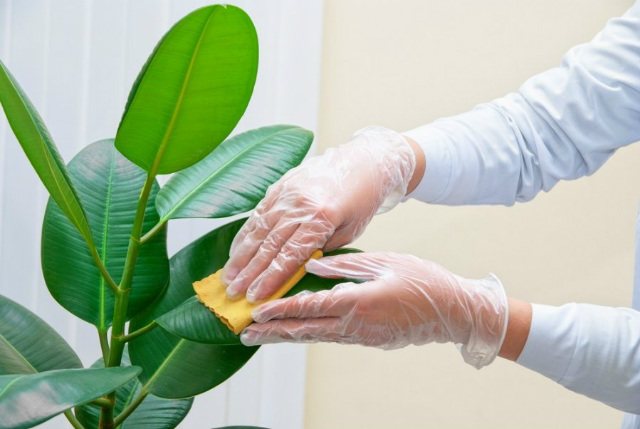

Use of fungicides
Chemical measures to combat powdery mildew with their timely and correct application are quite effective.
Fungicides (fungus - fungus and caedo - kill) are chemicals used to fight fungal diseases of plants.
Of the modern fungicides against powdery mildew, it is worth noting drugs: Bayleton, Zato, Quadris, Raek, Skor, Tilt, Topaz, Topsin, Fundazim, Fundazol, Acrobat Mts 69%, Kuproskat, Mancoceb (manganese dithiocarbamide), Tiovit Jet), colloidal Impact, Strobi - broad-spectrum fungicides, (Basf). All drugs are used in accordance with the instructions, without exceeding the dosage ..
Cases of the emergence of resistant races of the fungus to chemical preparations on some crops have been noted, therefore, the breeding of varieties resistant to powdery mildew is an extremely urgent issue.
Prevention is the best answer!
A heavily multiplied pest can greatly weaken or destroy the flower.Even small accumulations of parasites significantly impair the decorative properties of the plant. Fighting annoying aliens is tiring. What should be done in order not to darken communication with our silent friends with annoying troubles?
When purchasing a new pet, carefully inspect it so that it does not have the slightest sign of pests. After a new flower appears in the house, do not immediately put it next to other plants. Just in case, let him pass the "quarantine", being far from them. If everything went well, you can place it closer to the "old-timers", creating new interesting compositions. After the diseased plant has recovered, it must be transplanted. When replanting plants, use new flowerpots for them. If you want to transplant a flower into an old favorite pot, you must first boil it with soapy water.
Periodically carefully inspect home flowers, wipe their leaves, do not allow pests to settle on them. For some plants, it is allowed to have a warm shower from time to time.
The more attentively you treat flowers, the more magnificently the living decoration of your home will grow!
Mint care
Caring for mint consists in loosening the soil, hilling, watering (as needed) and weeding weeds. Plant feeding is carried out in early spring. To obtain more green mass in the spring, as it grows, it is recommended to carry out a strong pruning: the mint will bush better.
In protection from frost, the ridges are covered in autumn with a layer of loose earth, or covered with spruce branches, straw, dry leaves, spruce branches or manure. Planting mint should be renewed every 3-4 years, as they do not resist weeds well and fall out quickly.
Reproduction
The female forms cotton-like clusters from the secretions, which she uses to lay eggs. At a time, the female can lay about 2000 microscopic eggs in cooked fluffy formations, which they attach in the axils of the leaves or along the veins. The deposited testicles are protected by voluminous cotton secretions and therefore are not afraid of water. The grown larvae spread throughout the plant, even at the root collar and on the roots.
In scale insects, sexual dimorphism is clearly expressed.
Only males have wings, strong limbs, abdomen, two tail filaments.
Organisms that damage the leaf blade
It is difficult to identify a pest that destroys a plant. These are mainly insects or mites, that is, multicellular organisms. However, they are so small that it is difficult to see them. In addition, only a specialist can determine the type.
Nevertheless, it is necessary to know the enemies of plants. Here is a rough list of them.
- 1. Spider mites are the most common pests of indoor plants. They are arachnids. Their presence is usually detected by indirect signs. The stickiness of the leaves is the first sign. Then subtle cobwebs appear. If the plant is in bloom, the cobweb will concentrate on the flowers. Chrysanthemums, citrus fruits, roses suffer most from spider mites.
- 2. Scabbards, or false scutes, are small insects from the Hemiptera family. They got their name for the fact that they look as if they were covered from above with a dense protective shell, similar to a shield. Compared to the mite, they are quite large - they can be seen with the naked eye. They lead a sedentary lifestyle. If you try to remove them from the plant, you can feel resistance. The feeling of adhesion of the scabbard to the surface of the sheet is created. They usually concentrate near the veins or on a young shoot.
- 3. Aphids for indoor plants are not as popular as the previous ones. The reason is simple - these insects are larger, so people notice them faster and take action. However, they are colored to match the color of their food base, which reduces the likelihood of their early detection.Infection with these insects occurs quickly. This is due to their ability to fly. If previous pests migrate through the soil, then these can fly to new plants.
- 4. Mealybugs are members of the same family as the scale insects. These worms are not worms at all. In size and lifestyle, they are more like aphids. A person who is not versed in the biology of invertebrates usually does not see the difference between aphids and a scale insect. However, there are some indirect indications. The accumulation of these small white insects creates a white bloom effect, as if the plant was sprinkled with flour.
- 5. Whiteflies are small white butterflies. They are usually concentrated on the underside of the leaf, since the cover is less hard there.
These butterflies lay their eggs where they feed. Translucent larvae emerge from the eggs, bite into the leaves, move along their surface, leaving a layer of sticky sweet bloom. If the concentration of larvae is high, and the leaves are not processed, then the plaque turns from green to black. This is due to the fact that fungi begin to multiply in a sweet environment.
The spider mite forms thin, poorly visible spider webs. A white, viscous bloom is most likely a POWY WORM, a sucking insect, a relative of the scale insect and aphids.


Some plants are less susceptible to it, and it attacks some very strongly, for example, Kalanchoe and euonymus. I myself faced this problem and solved it. It is quite difficult to fight, in the future there may be relapses, especially if something is not done very carefully, so henceforth you need to look at your plants in order to detect the appearance of pests in time. And now you will have to: 1) remove adult insects (gray-green, 1-2 mm long) and egg clutches from the plant (as if in white patches of fluff). This is done gently, often replaced with small cotton swabs dipped in rubbing alcohol (buy from your pharmacy). The alcohol must be strong enough to evaporate quickly and not stagnate on the plant, then it will not burn the skin! I myself was surprised, but this explanation was read from a book on indoor plant growing, they advise 96% alcohol there (so that it instantly evaporates). Evidently, the fact is that not only mechanically adult insects are removed, but also the smallest young individuals die from alcohol, and at the same time the sugary sticky secretions are washed off, which stains the plant and on which a black sooty fungus or mold can then settle. 2) After that, very carefully treat with an insecticide solution. Best of all is Aktara - you can spray it with it and shed the soil, from this the plant will become poisonous for pests for several weeks. If you buy another product, a cut only for spraying (I used Aktellik, it is also from a spider mite), they need to spray the plant well from all sides and from bottom to top, from the inside of the leaves. Place the plant pot in a large plastic garbage bag, spray in it to keep the poison from flying around, then tie the top up and leave it there for a few hours. Follow the instructions - process in a room where there are no children, animals, and the aquarium must be closed from above. I do this in the bathroom, at the bottom of the tub. Since the worm tends to spread throughout the entire collection of plants, you will have to process everything that stood with the infected one! And also wipe the windowsill and frames with a solution of poison where these plants stand. 3) The treatment with poison will have to be repeated once or twice with an interval of 7-10 days, since eggs could remain on the plant or in the soil, on which the poison does not work, and by this time a new generation of pests will have emerged, that's what they are it is necessary to "cover". Success and patience!
otvet.
Gray rot
Gray rot can be just as troublesome. It is caused by the fungus Botrytis cinerea. It looks like patches of fluffy gray bloom on the plant - on the stem, leaf stalks. Subsequently, the part of the plant damaged by the fungus rots.The disease is spreading very quickly! The plant may disappear completely.
To protect your flowers from fungi, avoid stagnation of water in the ground, moisture on the leaves, and regularly ventilate the room. There should be some space between the pots for the leaves to breathe, so don't place the flowers too close to each other.
There is no reliable cure for gray rot; the affected plant will have to be destroyed so that the disease does not spread to other plants.
If the gooseberry has been growing in your dacha for a long time, you got the bush from your grandmother, and she once took cuttings from your great-grandmother, most likely the problem of powdery mildew is familiar to you firsthand. This whitish bloom on the leaves and stems, brown spots on the berries, which are peeled off if you try, but still not pleasant. Old varieties are good because they are tasty and definitely have not undergone any modifications, but the problem is that they are not at all resistant to various diseases.
You don't want to get rid of a tasty variety, but you don't want to defeat powdery mildew. In this case, it would be good to do without toxic pesticides. There are effective folk remedies for the prevention and control of powdery mildew. And they have been tested in practice.
The disease of gooseberries, which everyone calls powdery mildew, is called spheroteka. It affects all parts of the bush: leaves, shoots, ovaries, berries. At first, the plant is covered with a white bloom, and over time it turns into brown, resembling felt. The affected shoots are bent, the leaves curl, and the fruits are poorly poured.
The disease is caused by a genus of fungi of the same name, which throw out spores twice: in spring and summer. Therefore, in an amicable way, you need to carry out three treatments of gooseberries from powdery mildew: before flowering, immediately after flowering and before leaf fall. In this case, it is better not to spray the bushes, but to soak, trying not to miss a single branch. In addition, it is important to remember that the spores of the fungus overwinter in the litter, that is, it is imperative to shed the earth around the bush with the same means. Processing is recommended in the evening.
Folk remedies for powdery mildew on gooseberries
Ammonium nitrate 50 grams of ammonium nitrate is dissolved in 10 liters of water. Gooseberries are processed after flowering.
Aspirin + Soda 1 tbsp soda, 1 aspirin tablet, 1 tsp. dishwashing liquid or liquid soap, 1 tbsp. vegetable oil is dissolved in 4.5 liters of water. The bushes are treated with this composition once every two weeks during the season.
Water Water should be brought to a boil. In early spring, before the snow melts, gooseberry bushes are poured with boiling water directly from the watering can.
Gaupsin or Trichodermin (biologics) 150 ml. the drug is dissolved in 10 liters of water. Spray gooseberries during the growing season at intervals of 2 weeks.
Ash Option 1. One kilogram of ash is poured with 10 liters of water and insisted for 7 days, sometimes stirring. Then carefully pour the infusion, leaving the sediment at the bottom. Option 2.300 grams of ash is mixed with 10 liters of water, brought to a boil and boiled for 30 minutes. Then it is cooled until a precipitate appears and carefully poured into a clean dish. Option 3.3 kg. ash is poured with 10 liters of boiling water and insisted for a day. Then filter. Spraying is carried out in late May - early June three times with an interval of one day. The ash residue is diluted with water and poured over the soil under the bushes with this mixture.
Soda ash 50 grams of soda ash is dissolved in a small amount of hot water, then the water is brought to 10 liters and 10 grams of liquid soap is added. Gooseberries are processed twice: before flowering and after flowering.
Kefir or sour milk 1 liter of kefir or sour milk is mixed with 9 liters of water. Processing is carried out three times every three days.
Mullein Mullein is diluted with water in a ratio of 1: 3 and insisted for three days. Then again diluted with water 1: 3 and filtered.Gooseberries are processed before flowering, after flowering and before leaf fall.
Onion peel 200 grams of onion peel is poured with 10 liters of boiling water and insisted for 2 days. Gooseberries are processed before flowering, after flowering and before leaf fall.
Whey 1 liter of whey is mixed with 9 liters of water. Processing is carried out three times every three days.
Tansy 30 grams of dry tansy is poured with 10 liters of water and infused for 24 hours. Then it is boiled for 1.5-2 hours and filtered. A decoction of tansy is used to cultivate the land around the bushes in spring and autumn.
Fresh hay or forest litter The bucket is filled with hay by a third, topped up with water and infused for three days. Then again diluted with water 1: 3 and filtered. Gooseberries are processed before flowering, after flowering and before leaf fall.
Soda 2 tablespoons soda and 50 grams of grated laundry soap are dissolved in 10 liters of water. Bushes are processed twice: before flowering and after flowering.
Fertilizers For 10 liters of water, 20 grams of superphosphate, 50 grams of potassium chloride, 30 grams of urea, 5 grams of potassium permanganate are needed. Gooseberries are sprayed once after flowering.
Fitosporin Take 100-150 ml. preparation for 10 liters of water. The bush and the soil under it are cultivated in the spring before flowering and in the fall after fruiting.
Horsetail 1 kg. fresh horsetail is poured with 10 liters of water and boiled for 2 hours. The broth is cooled, filtered and diluted with water 1: 5. Spray gooseberries during the summer season at weekly intervals.
In conclusion, I would like to say that powdery mildew, like many other fungal diseases, is very fond of moisture, thickened plantings and poor organic soil. Therefore, firstly, you need to try to regularly cut out old, poorly fruiting branches so that the air can freely penetrate into the bush, and secondly, to heal and enrich the soil with organic matter. Instead of digging under the bushes, weeding out all the weeds and removing the litter (what if there is a fungus lurking there?), It is better, on the contrary, to put tops under the gooseberries (the tops of nightshade: potatoes and tomatoes are especially good) and spill it abundantly on top with a solution of EM preparations ... Beneficial microorganisms quickly get down to business and "squeeze" organic residues along with pathogenic fungi. We wish you success and big harvests!
A source
White spots: where are they from?
The reasons for the appearance of white spots on home plants can be:
- defeat by a pest - mealybug
- fungal diseases - powdery mildew, downy mildew, white rot, mold
Mealybugs are sucking insects that leave sticky drops and white discharge that resemble cotton balls on the leaves. You can clean the leaves from them with a disc moistened with alcohol or soapy water. The plants are then sprayed with insecticides, which are widely available on the market.
Following the instructions, the drugs will have to be used repeatedly until the worms are completely destroyed. Important. A diseased plant must always be quarantined immediately.
Fungal lesions are promoted by increased room humidity, sudden temperature changes, overcrowding of plants and their weakened state. An excess of nitrogen fertilizers and a lack of calcium in combination with inappropriate conditions of detention also provoke the development of fungal infections. Fungal diseases are highly contagious: spores are carried with the ground, through the air with dust, with new plants. Saintpaulias, begonias, chrysanthemums, hydrangeas are most susceptible to fungal infections.
Types of fungal diseases
Diseases that appear on plants with white spots are caused by various types of fungi.
- Powdery mildew. This is a rapidly spreading fungal infection of indoor plants. The leaves quickly become covered with white powdery spots - mycelium, which is easily peeled off. Then white bloom captures other parts of the plant. The spots increase, become "felt" and acquire a brown color.Infected leaves wither and fall off, shoots do not develop, the plant is inhibited.
- Downy mildew. It differs from the real one in that the plaque first appears on the underside of the leaf blades, then turns brown. White rot. A white rot fungus infects the stem through the soil. The lower leaves lose their natural color and become covered with white fragments, the top of the plant withers.
White mold caused by the development of fungal microflora due to waterlogging of the soil can appear right on its surface. White mold stains should be distinguished from salt stains on the ground, caused by a chemical reaction and associated with the composition of the water used for irrigation. Mold islands give a specific rotten smell and are easily rubbed in the hands.
Fundazol
Produced in powder form, the drug is another broad-spectrum fungicide, i.e. used against many fungal diseases of the lawn.
Its antifungal effect is based on the suppression of the multiplication of fungi by the active substance (benomyl) due to the violation of nuclear division in their cells.
This therapeutic effect of the drug against powdery mildew lasts for 3 days after treatment, then the protective function remains for another week.
The tool can be used both for spraying and for watering the lawn. For this, 1 g of the drug is diluted in a small amount of water, then liquid is added to a volume of 1 liter.
If it is necessary to make several treatments, an interval of 10-14 days is left between them.


